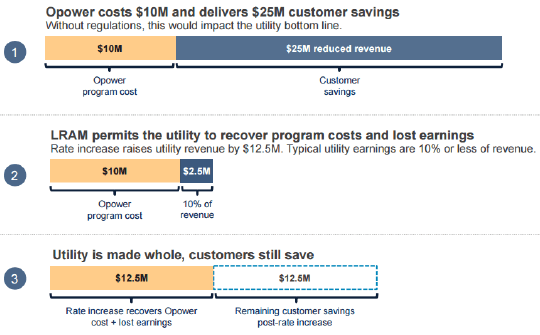Opower: Harnessing the Power of Data to Save Energy

Opower leverages your energy consumption data to create value for customers, the utility, and the world
Introduction
The energy industry is the largest industry in the world economy today, yet it remains largely undisrupted by the technological advances of the last two decades, especially compared to industries such as communications or retail. As fossil fuels become more scarce and more difficult to excavate and climate change becomes one of the most pressing challenges of this generation, it is more important than ever that we find technology solutions to optimize and change the way generate, transport and utilize energy.
Opower (now part of Oracle) is leading provider of customer engagement and energy efficiency cloud services to the utilities space. It utilizes the utility data to engage utility customers in order to provide better customer service, empower customers to be more energy efficient and allow utilities to better leverage new technologies such as smart meters. For the past 100+ years, our relationship with our utility has been a simple one; they produced energy and we consumed it, now Opower is allowing both customers and the utility to have a more active relationship with each other.
Value Creation with the Power of Data
Energy Efficiency
Opower’s core and oldest product is its Energy Efficiency product which focuses on encouraging customers to be more energy efficient and become more involved with various energy efficiency programs. [1] It utilizes historical data on customers provided by the utility such as energy usage, billing, customer activity, demographic and weather data to produce recommendations for the customer on their monthly energy bill or through alerts. One of the key examples of a report is a comparison of a customers’ energy usage to other similar sized households in their neighborhood. Utilizing behavioral science concept and the data collected, Opower can call out to customer if their energy usage is unusually high compared to neighbor, creating an intrinsic desire to then lower energy bills. It can also keep track of energy usage patterns within month and send an alert to customer of a “high bill” warning, prompting customers to change their behavior or give advance notice of a high bill to avoid the end of month surprise. [2]
It may seem strange that an utility would want to promote energy efficiency given the way the utility makes money is charging customers for the energy that they use, so would actually want to increase energy usage. However, given the regulated nature of utilities and utility rates, the regulatory bodies have avoided this negative incentive by the way that rates are structured. The regulatory body, in order to incentivize energy efficiency, have created a lost revenue adjustment mechanism which allows utilities to recover the cost of Opower and recoup earnings from reduced energy usage through rate increases. This benefits both the utility, as it can keep its revenue base while reducing utilization of its most expensive generation assets while still allowing its customers to realize cost savings, since rate increases have no associated costs against them vs. growing earnings through increase energy usage.
Demand Response
The adoption of smart meters, which are able to able to measure consumption by time rather than just merely total consumption, has enabled utilities to have greater detail of data on the consumer. Opower’s demand response allows utilities to leverage this data and communicate with customers to reduce their energy usage during times of highest demand. [3] Utilities turn on their generation assets in order from lowest cost to highest cost sources, so if they are able to avoid having to turn on the incremental high cost peaker plant, it is more profitable and cost-effective for the utility. Previously customers were not aware of when these peak times were as there was neither the smart meter hardware nor the Opower software to analyze and communicate the data output to customers.
Journey to Now and the Journey Forward
Opower was one of the early companies in the so-called “smart grid” ecosystem which sought to transform the legacy electrical grid into a more technologically advanced version which could efficiently allocated across generation sources, respond to active events in the grid, and utilize the power of data and technology to run optimally. Few people realize just how archaic the grid today is; for example, most people do not realize the way outage and down power lines are recognized today is through a customer calling, there’s not active detection in the grid itself.
The Company was unique in targeting a niche customer pain point, which few competitors operated in, which was leveraging the data from utilities to provide a superior customer experience and proactively engage the customer in energy saving initiatives. Just because utilities are largely regulated monopolies does not mean that they should not seek ways to improve their customer experience, especially if customer initiatives can create value for both the utility and the customer and at the same time produce the positive externality of reducing greenhouse emissions.
Opower’s value capture model is through selling its cloud suite in the form of a SaaS solution to various global utilities. While usually this creates a stable and recurring set of revenues, the size of any new customer was significant enough to create substantial volatility in its revenue and earnings base. Combined with a very long sales cycle to sell its product, this produced heavy pressure on its stock price as bookings and revenues were much harder to predict than investors typically expect of a recurring revenue SaaS business. The limited universe of global utilities also made it difficult to replace the lost revenue of any lost customer, especially given the long sales cycle of the business. [2]
While it has a successful IPO, and the product certainly provides substantial customer value, the mismatch between the way the product was marketed (fast growing SaaS business) and the reality of what the business was likely put substantial pressure on the stock price. This dynamic likely made it an attractive acquisition target, and Opower was ultimately acquired for about half of its IPO price by Oracle in June 14, 2016. [4]
As the grid become increasingly complex through the integration of a more diverse range of generation sources, some of which are intermittent, the inclusion of storage as a new aspect of grid construction and the growth of various forms of distributed generation at the household and community level, it will be crucial to have the necessary technology to manage our energy grid. As smart meters, more intellgent and interconnect grid hardware and smart devices such as Nest thermostats, smart lights and smart appliances gain increasing penetration, more data will be generated than ever before. Companies like Opower, which can take this mass of data, and create effective software to analyze and utilize this data will become increasingly more valuable and important.
[1] https://www.oracle.com/industries/utilities/products/opower-energy-efficiency-cloud-service/index.html
[2] Avondale Partners Research Report. Opower, Inc. 8 February 2016
[3] https://www.oracle.com/us/assets/opower-general-presentation-3003202.pdf
[4] https://www.greentechmedia.com/articles/read/oracle-acquires-opower






Great piece. It’s been interesting to watch Opower also use data to encourage consumers to get people to care about saving energy. In 2012, Facebook partnered with Opower and the NRDC to create a social application that would not just allow Opower to access the data about neighbors’ energy usage and call the customer, but also allow individuals themselves to track their own consumption relative to the people around them (playing up that competitive dynamic). Was a cool, innovative way to motivate consumers to take action and leverage this massive database. Will be interesting to see what Oracle does here.